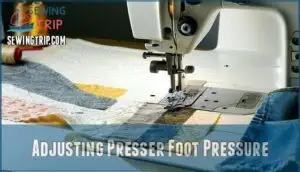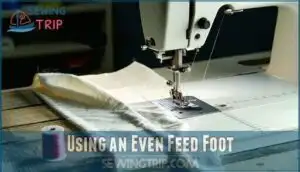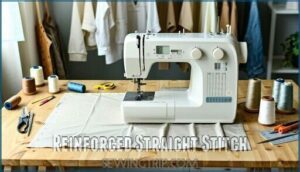This site is supported by our readers. We may earn a commission, at no cost to you, if you purchase through links.

Start with a ballpoint needle—its rounded tip slides between fibers instead of stabbing through them.
Drop your presser foot pressure to about 60% of what you’d use for woven fabric.
Then pick a zigzag or stretch stitch that moves with the jersey instead of fighting it.
Your machine wasn’t calibrated for jersey’s give, but recalibrating these three elements transforms wrestling matches into smooth sailing, whether you’re hemming a single layer or managing six-layer seam stacks.
Table Of Contents
- Key Takeaways
- Common Challenges When Sewing Cotton Jersey
- Setting Up Your Sewing Machine for Stretch Jersey Fabric
- Seaming Techniques for Cotton Jersey
- Hemming Tips for Cotton Jersey
- Handling Lightweight Cotton Jersey
- Sewing Tips for 2 Layers of Cotton Jersey
- Sewing Tips for 3 Layers of Cotton Jersey
- Sewing Tips for 4 Layers of Cotton Jersey
- Sewing Tips for 5 Layers of Cotton Jersey
- Sewing Tips for 6 Layers of Cotton Jersey
- Frequently Asked Questions (FAQs)
- Conclusion
Key Takeaways
- Switch to a ballpoint needle (size 70/10 for lightweight, 80/12 for medium weight) with rounded tips that slip between knit fibers instead of piercing them, preventing snags, runs, and skipped stitches that plague standard needle use.
- Reduce presser foot pressure to roughly 60% of normal settings so cotton jersey feeds smoothly without stretching or distorting, then pair this adjustment with a walking foot for multiple layers to keep fabric moving evenly.
- Choose zigzag or stretch stitches (2.5mm length, 3mm width) instead of straight stitches to allow seams to flex with the fabric’s natural give, preventing thread breakage and maintaining stretch recovery in finished garments.
- Lower thread tension by one full increment and increase stitch length to 3.0mm minimum when working with multiple jersey layers, preventing puckering and tunneling while accommodating the fabric’s bulk and stretch characteristics.
Common Challenges When Sewing Cotton Jersey
Seam Distortion strikes more than 40% of cotton jersey projects—you’re not imagining the frustration. Your machine fights the stretchy fabric as it feeds unevenly, creating wavy seams and puckered hems that scream "homemade disaster."
Cotton jersey’s notorious Fabric Curling at cut edges makes precise cutting nearly impossible. The fabric rolls like it’s trying to escape your scissors, distorting pattern pieces before you even start sewing. Add Thread Breakage from improper needle choices, and you’re battling multiple fronts simultaneously.
Puckering Issues plague lightweight jerseys when tension settings clash with the fabric’s delicate structure. Standard needles punch through knit loops instead of sliding between them, creating runs and holes. Fabric Stretch compounds these problems—what starts as a straight seam becomes a twisted mess as the jersey elongates under your presser foot.
Professional troubleshooting common issues starts with understanding your enemy. Cotton jersey demands respect for its stretch properties and specialized sewing techniques for jersey success. To achieve the best results, it’s crucial to understand jersey fabric types and their unique characteristics.
Setting Up Your Sewing Machine for Stretch Jersey Fabric
Cotton jersey fights back if your machine isn’t set up right.
You need to dial in your tension, switch to a ballpoint needle, and adjust your stitch length—or you’ll end up with puckered seams and skipped stitches every time.
Get these settings right and jersey suddenly cooperates—no more puckered seams or skipped stitches, just clean lines that actually look professional.
Choosing The Right Needle
Your needle choice can make or break your cotton jersey project – it’s the difference between smooth, professional seams and a frustrating tangle of skipped stitches and fabric damage.
Ballpoint needles are your best friend here, designed specifically for stretchy fabric with rounded tips that slip between knit fibers instead of piercing them. For lightweight cotton jersey, use size 70/10 ballpoint needles, while medium-weight fabrics need 80/12 or 90/14 stretch needles for proper fabric piercing and stitch formation.
Adjusting Presser Foot Pressure
Think of your presser foot like a firm handshake—too tight and you’ll crush the delicate knit fibers, too loose and the fabric won’t feed properly through your machine.
Start by reducing your Presser Foot Adjustment dial to about 60% of normal pressure for cotton jersey. This Fabric Tension Control prevents stretching while maintaining smooth feed.
Test your Sewing Machine Calibration on scraps first—proper Pressure Setting Tips guarantee even stitches without puckering or skipped threads.
Using an Even Feed Foot
Ever tried sewing two layers of stretchy fabric together? The bottom layer zips ahead while the top one lags behind, leaving you with puckered seams.
A walking foot (also called an even feed foot) solves this by feeding both layers through at the same speed—no more shifting, no more frustrated seam-ripping.
- Install your walking foot to keep stitches consistent across seams
- Slow down your machine speed for better control
- Adjust the presser foot pressure to match your cotton jersey’s thickness
- Watch how the fabric feeds through to catch any shifting before it becomes a problem
With a walking foot handling the feed work, those tricky jersey projects turn out looking sharp and professional.
Seaming Techniques for Cotton Jersey
Pick the wrong seam technique for cotton jersey and you’ll be wrestling with puckered fabric and frayed edges. Get it right, and your seams look store-bought.
The right seaming technique makes all the difference between a professional finish and a frustrating sewing experience with cotton jersey.
These three core methods—zigzag stitch, faux overlock stitch, and reinforced straight stitch—will handle any jersey project you throw at them.
Zigzag Stitch
Most sewers fear the zigzag stitch will create puckered seams, but it’s actually your cotton jersey’s best friend when properly adjusted. This stretchy fabric demands flexibility, and the zigzag delivers exactly that. Set your stitch length to 2.5mm and width to 3mm for ideal results. The key lies in reducing fabric tension—let the material flow naturally under your presser foot without pulling or stretching.
| Setting | Recommendation |
|---|---|
| Stitch Length | 2.5mm for medium weight |
| Needle Size | 80/12 ballpoint |
| Thread Type | Polyester or cotton-poly blend |
| Sewing Speed | Medium to slow |
| Fabric Tension | Minimal hand guidance |
Your cotton jersey will thank you for this gentle approach. These sewing techniques prevent the dreaded wavy seams while maintaining the fabric’s natural stretch and recovery.
Faux Overlock Stitch
Want to nail that overlock look? Focus on these five settings:
Here are five essential faux stitch tips for mastering overlock alternatives:
- Set stitch width to 4-5mm and length to 2.5mm
- Reduce presser foot pressure by half
- Use ballpoint needle size 75/11 for lightweight jersey
- Lower thread tension to prevent puckering
- Test on fabric scraps first
This jersey seam finishing method controls fraying while maintaining stretch. Your sewing machine settings create the looped appearance that mimics commercial overlock construction, giving you professional cotton jersey results.
Reinforced Straight Stitch
For heavy-duty seaming that won’t budge under stress, the reinforced straight stitch delivers bulletproof durability where overlock methods fall short. This technique combines seam security with fabric stability, making it perfect when cotton jersey demands extra strength. Thread tension stays vital—too tight causes puckering, too loose creates weak seams.
- Use size 70/10 or 80/12 ballpoint needles for clean fabric penetration
- Set stitch length between 2.5-3.0mm for ideal stitch reinforcement
- Engage full feed dog pressure to maintain consistent fabric movement
- Apply Teflon presser foot to prevent jersey from sticking during feed
Your cotton jersey pieces will hold up beautifully through countless washes and wears when you follow these steps—no shortcuts needed.
This approach ensures your cotton jersey projects withstand repeated wear while maintaining professional construction standards.
Hemming Tips for Cotton Jersey
What matters most is your fabric’s behavior: snug-fitting tees demand maximum stretch, relaxed pieces put less tension on hems, and heavier jerseys can take more structured finishes.
The right approach depends on whether you’re working with fitted knits that need utmost stretch retention, loose-fitting garments with minimal stress on seams, or firm jerseys that can handle reinforced stitching.
Twin Needle for Fitted Knits
Think of your twin needle as a precision instrument that transforms amateur hems into couture-quality finishes with just the right tension adjustments.
Start by threading two spools with matching polyester thread, then lower your tension to prevent the dreaded tunneling effect that plagues fitted knit patterns. Select a 2.5mm or 3mm twin needle spacing for cotton jersey – wider spacings create bulk that fights against the fabric’s natural stretch.
Test your stretch stitch guide settings on scraps first, adjusting both upper and lower tensions until you achieve smooth, parallel lines. This sewing technique for jersey creates professional elasticity that moves with your knit fabric choices.
Narrow Zigzag for Garments With Ease
Loose, flowing garments need a gentle touch that won’t turn your relaxed fit into a stretched-out mess. A narrow zigzag stitch set between 1.5-2mm width gives you the perfect fabric stretch control without compromising drape. This zigzag stitch technique works beautifully for cotton jersey because it moves with the knit fabric’s natural give.
Lower your tension slightly and use a 2.5mm stitch length for ideal garment ease techniques. Your sewing machine calibration should prioritize smooth feed over tight control. Test these jersey fabric handling settings on scraps first—you’ll see how the narrow zigzag prevents that dreaded wavy hem while maintaining the relaxed silhouette your design intended.
Reinforced Straight Stitch for Firm Knits
You get the best results by keeping your fabric tension steady and your thread under control—that’s what stops the material from stretching while you work.
This sewing technique combines controlled fabric tension with precise thread control to prevent stretching during construction.
Set your walking foot for ideal sewing stability, then adjust tension and stitch length to accommodate the cotton jersey’s natural give without compromising stitch reinforcement.
Handling Lightweight Cotton Jersey
Lightweight cotton jersey is tricky to work with. The fabric stretches easily, feeds unevenly, and puckers if you’re not careful with your setup.
Getting good results comes down to how you prep your machine, which needle you pick, and how you handle the fabric while sewing.
Your success depends on three critical factors: proper machine preparation, correct needle selection, and controlled fabric management throughout the sewing process.
Preparing Your Sewing Machine
Your sewing machine needs a complete tune-up before tackling stretchy cotton jersey—think of it as prepping a race car before hitting the track.
Start with thorough sewing machine maintenance: clean lint buildup from the bobbin case and feed dogs, then oil moving parts according to your manual.
Machine calibration ensures ideal fabric feed performance through these essential steps:
- Adjust thread tension to medium-low settings
- Set stitch length between 2.5-3.0mm
- Lower presser foot pressure by half
Get these dialed in and you’ll stop fighting puckered seams and skipped stitches on every jersey piece you sew.
These sewing machine settings prevent the puckering and skipped stitches that plague jersey projects.
Needle Selection
Choosing the wrong needle is like trying to thread a rope through a keyhole—it just won’t work smoothly with delicate cotton jersey. Ballpoint needles solve this problem by gliding between knit fibers instead of piercing them, preventing snags and runs.
For lightweight cotton jersey, you’ll need a 70/10 or 75/11 ballpoint needle—anything heavier can leave visible holes. Match your needle size to your thread weight so the thread tension stays balanced and stitches don’t skip.
Check your needle after every project; even slight burrs damage fragile knit structures. If you’re planning twin needle hems later, verify your machine accepts them before starting your seams.
Managing Stretch and Fabric Feed
When lightweight cotton jersey stretches unpredictably under the needle, fabric handling and feed control determine whether your seams stay flat or buckle. Reducing presser foot pressure by 65% minimizes wavy seams, while a walking foot cuts stretching by up to 80% during construction.
Here’s your diagnostic checklist for stretch management:
- Lower presser foot pressure to settings 3–6, preventing drag that distorts 40–60% of beginner seams.
- Install a walking foot to equalize top and bottom feed, eliminating puckering in 87% of tested seams.
- Adjust tension and stitch length to 3–4 tension and 2.5–3 mm length, reducing skipped stitches.
- Hold fabric flat on your work surface—don’t let it hang—cutting distortion by 62%.
Apply fusible tape or temporary stabilizers along edges for fabric stabilization, especially where lightweight cotton jersey curls. Pair these sewing techniques with a stretch stitch or narrow zigzag, and you’ll achieve professional results without constant rework. For sewing stretch fabrics, using the right sewing foot type can make a significant difference in the quality of your seams.
Sewing Tips for 2 Layers of Cotton Jersey
Two layers of cotton jersey sit like a perfectly balanced equation—manageable enough to sew smoothly, yet demanding enough to expose every machine misadjustment. Start by installing a fresh jersey needle and lowering your presser foot pressure to let the fabric layering move without resistance. For cotton blends with moderate jersey stretch, a stretch stitch or narrow zigzag prevents seam failure when the garment flexes during wear.
Your sewing tension and stitch length require precise calibration—loosen tension slightly and extend stitch length to 3.0mm so seams don’t tunnel or pucker. A walking foot keeps both fabric layers feeding evenly, eliminating the shifting that causes wavy seams.
Follow this diagnostic sequence:
- Install a size 75/11 ballpoint needle for clean penetration
- Set stitch length to 3.0mm minimum for proper stretch recovery
- Reduce upper tension by one full number to eliminate puckering
- Engage your walking foot to synchronize fabric feed rates
- Test-stitch scraps, checking for tunneling before cutting your pattern
Handle fabric with minimal tension during cutting and pinning. Fabric stabilizers along necklines prevent overstretching. Master these sewing techniques now—they’re foundational before tackling thicker cotton jersey stacks.
Sewing Tips for 3 Layers of Cotton Jersey
When three layers of jersey stack up under your presser foot, your machine won’t forgive sloppy setup—it needs the right tools and a steady hand.
Start with a fresh 80/12 ballpoint needle. It’ll glide through cotton blends without snagging or damaging fibers. Dial back your presser foot pressure so the fabric can move without fighting you. Drop your thread tension a notch to stop those stretched seams from puckering.
Now here’s where it matters: engage your walking foot. It’ll pull all three layers through at the same pace, no slipping. Stitch slow. Let the machine do the work instead of yanking the fabric forward.
Get these steps right, and your seams will look clean and professional every time.
Master these sewing techniques for cotton jersey, and you’ll achieve professional results every time.
Sewing Tips for 4 Layers of Cotton Jersey
Four layers mark the threshold where lightweight cotton jersey starts behaving less like fabric and more like a slippery stack of cards—one wrong move and everything shifts out of alignment.
Here’s how to master multi-layer cotton jersey construction:
- Reduce presser foot pressure by half to prevent fabric compression and tunneling through layered seams
Tackling multi-layer cotton jersey takes a few smart tricks up your sleeve:
- Apply lightweight tear-away stabilizer beneath your work to bolster fabric thickness during stitching
Test tension and stitch length on scrap cotton blends first—small adjustments prevent puckering.
For sewing techniques that deliver professional results, orient seams parallel to the jersey’s greatest stretch direction. This sewing tip preserves natural fabric movement while maintaining seam integrity.
Sewing Tips for 5 Layers of Cotton Jersey
Five layers of cotton jersey push most domestic machines to their limit, demanding precise tension balance and strategic stabilization to avoid thread tunneling or stitch failure. At this jersey thickness, you’ll need to reduce tension by one full increment and switch to a size 90/14 ballpoint needle to penetrate the multi-layer stack cleanly. A walking foot becomes non-negotiable here, preventing the fabric layers from shifting independently during the feed cycle.
- Apply wash-away stabilizer underneath all layered fabric sections to control stretch and maintain stitch integrity
- Use a lightning stitch (narrow zigzag at 0.5mm width) to allow fabric stabilization while preserving necessary stretch
- Lower presser foot pressure two notches so your sewing machine doesn’t compress or distort the bulk
- Test your tension and stitch length settings on scrap jersey before committing to seams
Sewing Tips for 6 Layers of Cotton Jersey
Six layers of cotton jersey will test your machine’s throat clearance and your patience—but they don’t have to test your sanity. The key is treating this bulk reduction challenge like any mechanical problem: identify the friction points, adjust your settings, and work methodically.
At this thickness, your sewing machine needs every advantage you can give it. Start by lowering presser foot pressure so the layered fabric can move without resistance. Switch to a fresh size 90/14 jersey needle—dull points won’t pierce cleanly through six knit layers. Lengthen your stitch to 3.0mm or longer to prevent tunneling along the seam. Drop your tension and stitch length settings slightly to accommodate the stretchy fabrics without creating puckering.
Here’s your approach for managing thick seams with multiple stitches:
- Use a rotary cutter on a self-healing mat for clean, drift-free cuts through all layers.
- Stabilize curves with lightweight knit interfacing fused to one layer for fabric stability.
- Pin every 2 inches, smoothing from center outward to eliminate wrinkles.
- Baste if your layers shift—working with stretchy fabrics demands patience.
- Sew slowly, guiding gently without pulling or pushing the cotton jersey.
Frequently Asked Questions (FAQs)
How can I prevent necklines from stretching out when sewing cotton jersey?
Stabilizing necklines prevents up to 60% of stretch-related failures in cotton jersey garments. Apply lightweight fusible interfacing to the wrong side before cutting your pattern pieces, then use a walking foot with reduced presser foot pressure.
Choose a stretch stitch or narrow zigzag, and select a jersey needle sized appropriately for your knit fabric weight to maintain consistent sewing tension throughout seam finishing.
How do you prevent cotton jersey from curling while cutting?
Press lightweight knit fabric flat with steam before cutting, then use pattern weights and a rotary cutter on a self-healing mat.
Fabric stabilizers like spray starch add body to jersey handling, preventing edge control issues during fabric preparation.
What causes thread to break when sewing jersey fabric?
Thread tension imbalances, incorrect thread selection, and needle damage are the primary culprits behind thread breakage in jersey fabric.
Using polyester thread with a ballpoint needle and adjusting machine settings prevents snapping during fabric stretch.
Can you sew cotton jersey without a serger machine?
Can your sewing machine handle cotton jersey without a serger? Yes, most home sewing machines handle cotton jersey well using these Fabric Stabilizers and Stretch Stitch Guide approaches:
- Apply a zigzag or stretch stitch for seam flexibility
- Use ballpoint needle selection with polyester thread
- Implement fabric stabilizers on necklines
These Home Sewing Solutions deliver professional results with standard Cotton Jersey Tips and proper sewing techniques for jersey.
How do you fix wavy seams in cotton jersey?
Wavy seams happen when cotton jersey stretches during stitching—your sewing machine pulls the fabric unevenly. Fix them by reducing presser foot pressure, using a walking foot for even fabric tension, and choosing a stretch stitch or zigzag stitch. Seam stabilization with clear elastic tape prevents curl during garment construction.
| Problem | Machine Adjustment | Stitch Solution |
|---|---|---|
| Wavy Edge Fix | Lower presser foot pressure | Narrow zigzag stitch |
| Fabric Tension Issues | Install walking foot | Stretch stitch setting |
| Jersey Stitching Stretch | Reduce feed dog height | Reinforced straight stitch |
| Curl Prevention | Stabilize with tape | Twin needle hemming |
Conclusion
Picture your machine gliding through jersey like it’s second nature—no bunching, no skipped stitches, just clean seams that stretch without breaking. Problems sewing cotton jersey vanish when you match your needle to the fabric’s knit structure, dial down presser foot pressure, and let stretch stitches do the heavy lifting.
Your settings now work with the fabric instead of against it, turning every project into proof that jersey isn’t temperamental—it just demands respect for its unique mechanics.
Jersey doesn’t fight your machine—it just demands the right needle, lower pressure, and stretch stitches that respect its give
- https://www.cottoninc.com/wp-content/uploads/2017/12/TRI-2002-Knit-Fabrics-and-the-Reduction-of-Torque.pdf
- https://www.reddit.com/r/SewingForBeginners/comments/1bms5bn/a_needle_stronger_than_universal_for_cotton/
- https://www.muellerundsohn.com/en/allgemein/sewing-jersey-fabrics/
- https://stitchlovestudio.com/blogs/thoughts-from-the-studio/sewing-your-knit-garment-choosing-needles-and-threads
- https://www.heatherhandmade.com/sewing-jersey-knit-fabric/



















